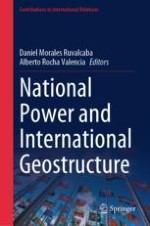2024 | OriginalPaper | Chapter
4. The International Geostructure of Power: A Trans-Structural Approach
Authors : Daniel Morales Ruvalcaba, Alberto Rocha Valencia
Published in: National Power and International Geostructure
Publisher: Springer Nature Singapore
Activate our intelligent search to find suitable subject content or patents.
Select sections of text to find matching patents with Artificial Intelligence. powered by
Select sections of text to find additional relevant content using AI-assisted search. powered by
